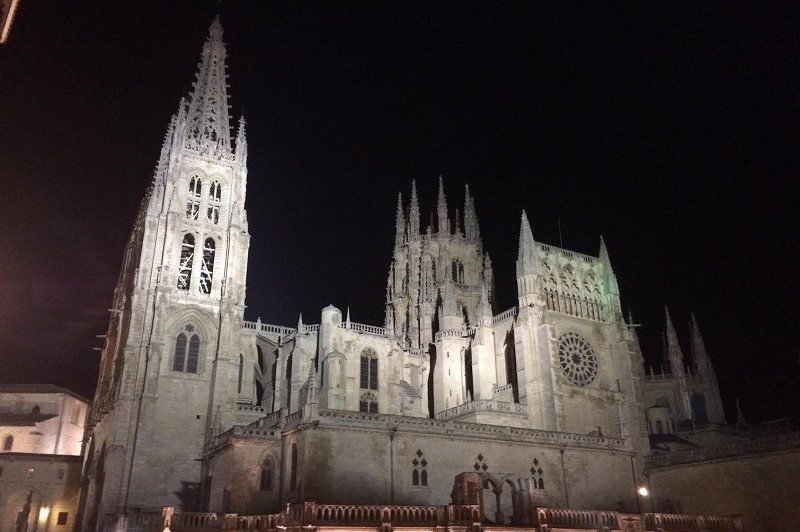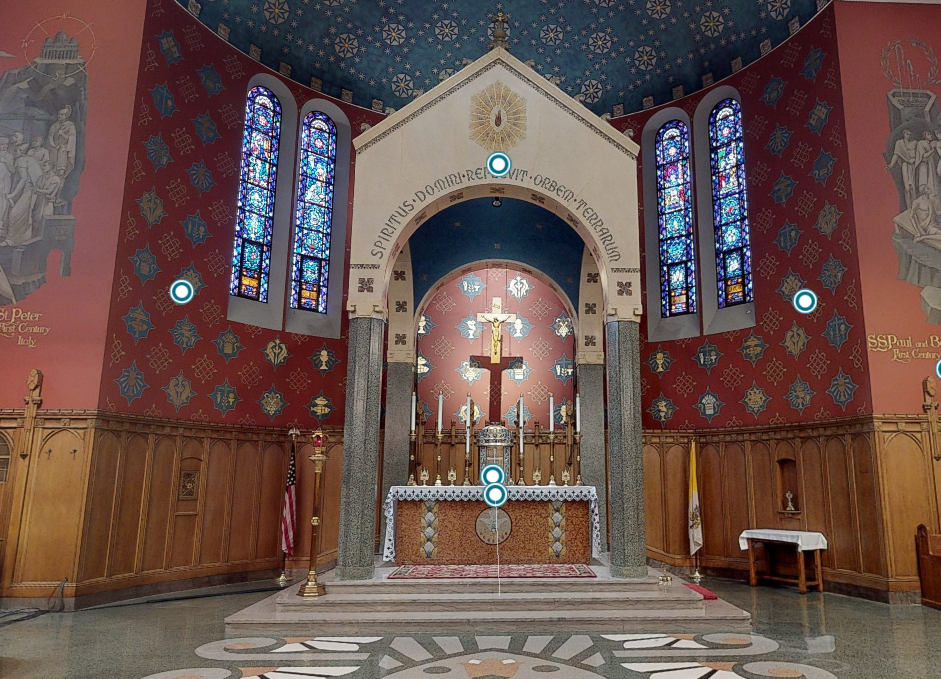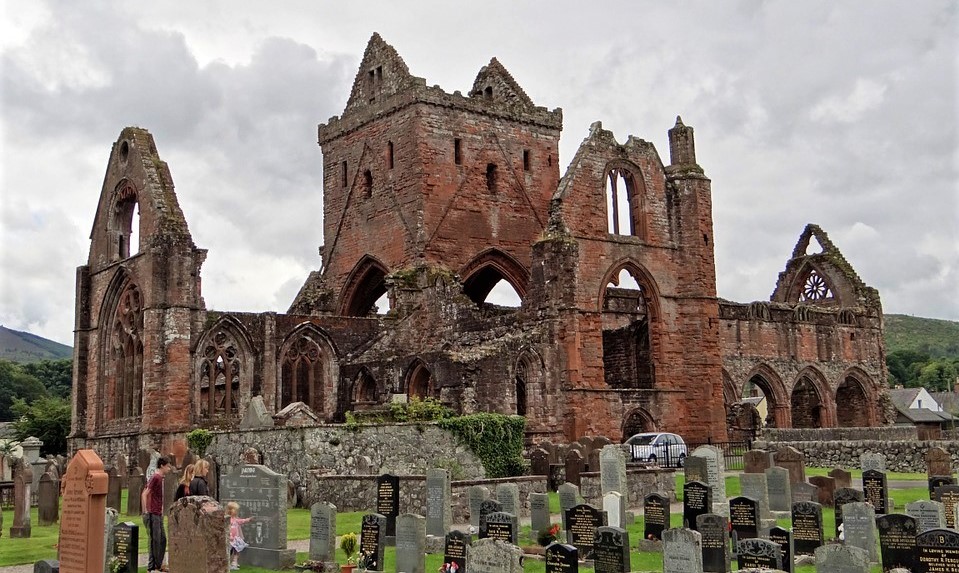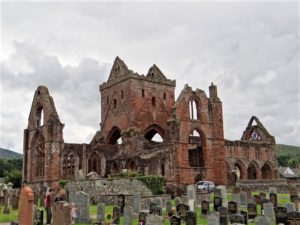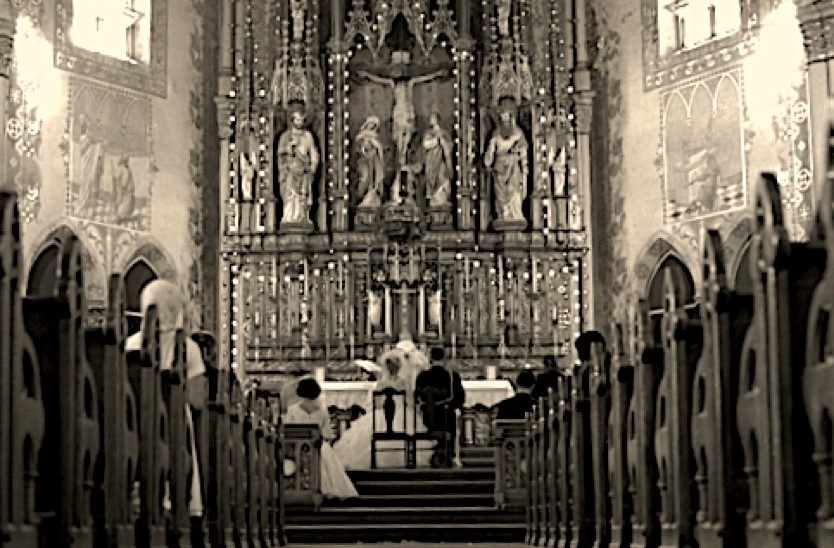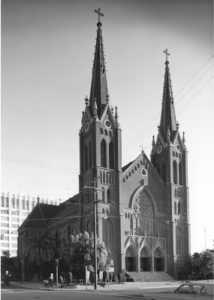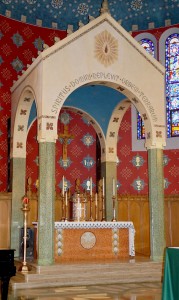I was recently in Burgos, Spain and saw the splendid cathedral there. My first view of it came at night and I took the photo above. What a magnificent building; such proportion and symmetry! It reminds me of tall trees in a forest, majestically reaching up to the heavens. The flying buttresses supporting the soaring walls and towers showcase a great advance in building technique.
These were the skyscrapers of the Middle Ages. Such angular, geometric, and vertical beauty; almost like a forest, a fair flower of the 13th century echoing God’s creation and pointing to Him in a great work of human praise.
Two medieval phrases come to mind in the beauty of this building:
-
-
- Beauty is id quod visum placet – Beauty is that which pleases when seen.
- Pulchra dicuntur quae visa placent – Things that give pleasure when seen are called beautiful.
-
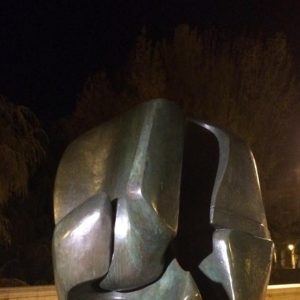 A mere thirty yards from this beautiful cathedral in the town square is something that is not beautiful in any traditional sense. I took the photo of it that is on the left. It was not uplifting and seemed to correspond to nothing in creation (unless one were to imagine a dinosaur dropping or a huge stumbling block). Like most modern abstract art, it looks more to me like someone’s nightmare. It seems to have little to say other than “Try to figure me out, you ignoramus.” Indeed, that is what I am usually called by art critics when I express dismay at these sorts of ugly blobs that clutter too many of our public squares and “art” museums.
A mere thirty yards from this beautiful cathedral in the town square is something that is not beautiful in any traditional sense. I took the photo of it that is on the left. It was not uplifting and seemed to correspond to nothing in creation (unless one were to imagine a dinosaur dropping or a huge stumbling block). Like most modern abstract art, it looks more to me like someone’s nightmare. It seems to have little to say other than “Try to figure me out, you ignoramus.” Indeed, that is what I am usually called by art critics when I express dismay at these sorts of ugly blobs that clutter too many of our public squares and “art” museums.
Some disparagingly refer to the Middle Ages as the “dark ages” while referring to the current age as “enlightened.” Certainly, no age is perfect, but compare and contrast the two items in the photos here: uplifting, soaring, and inspiring; the other is dark and brooding, and its meaning is opaque. One is an uplifting building from the 13th century, the other a dark “who knows what” from the 20th century. Based on representational art, which age seems more inspiring? Which seems more enlightened? Decide for yourself, but I’ll take the 13th century!
Generally speaking, the idea at work in modern art is that it is merely the expression of the artist. We who view it are supposed to respect the artist expressing himself. This is largely a outgrowth of the subjectivism that fills our time.
The ancient idea however was that art is recta ratio factibilium (right reason in regard to things that are made). So the ancient ideal in things to be made, including art that the focus is not me, is not the artist, it is whether the art reflects conformity to the way a reasonable person can perceive the world. This does not mean that every painting must be like a photograph, or that sculpture should be an exact replica of what is. But it does mean that it has some conformity with reality that a reasonable person can perceive. So much modern art (not all) is either meaningless, or has no set meaning, it does not appeal to our reason or speak to our communal understanding of the reality about us.
Hence, St. Thomas Aquinas (also from the 13th century) spoke of beauty as consisting of integritas, consonantia, and claritas. He writes,
For beauty includes three conditions: “integrity” or “perfection,” since those things which are impaired are by the very fact ugly; due “proportion” or “harmony”; and lastly, “brightness” or “clarity,” whence things are called beautiful which have a bright color [Summa Theologica I, 38, art 8].
In applying these criteria to art and architecture, we might consider the following:
Integritas (Integrity) – This speaks to the manner in which something echoes the beauty of what God has done. Thomas says that every created being is beautiful because God gives beauty to all created beings by a certain participation in the divine beauty. Therefore, human art and architecture are said to have integrity insofar as they participate in and point to the divine beauty of things. This need not mean an exact mimicry, but it does require at least a respectful glance to creation, holding forth some aspect of it so as to edify us with better and higher things. The cathedral pictured above points to a majestic forest as its form, its soaring stone to the mountains. Its colored glass allows the natural light to dazzle the eye and tell the stories of the Gospels. It is a sermon in glass and stone. As such, it has integrity, because it puts forth God’s glory. I’m not sure what the dark metal blob says. To what does it point? I have no idea. Because it is not integrated into the glory of creation (in any way that I can discern, at least) it does not have integrity. Rather, it seems to mock creation. If you think it is beautiful and has integrity, I invite you to explain why and how; I am at a loss to see any meaning at all in it.
Consonantia (Proportion) – This refers to the order and unity within a given thing. What God creates has a unity and purpose in its parts, which work together in an orderly fashion to direct something to its proper function or end. Thus, art and architecture intrinsically bespeak a unity and functionality, or they point to it extrinsically. They make sense of the world and respect what is given, reflecting the beauty of order, purpose, and design that God has set forth. The cathedral is beautiful because its parts act together in an orderly and harmonious way. There is balance, proportion, and symmetry. There is a recta ratio factibilium (something made according to right reason). As such, the building participates in God’s good order, and that is a beautiful thing. As for the dark metal “blob” (I don’t know what else to call it), it doesn’t seem to me to have any proportion. It is roundish, but not really. Does it have parts? Do they work together for some end? If so, what end? I cannot tell. Rather than pointing to order, it makes me think of chaos. I see no beauty echoed or pointed to.
Claritas (Clarity) – It is through clarity that we can answer the question “What is it?” with some degree of precision and understanding. Claritas also refers to the brightness or radiance of a thing. Something of God’s glory shines through; something about it gives light; something teaches us and reminds us of God—and God and light are beautiful. The gorgeous cathedral reflects the light shining on it, even at night. During the day it proclaims the glory of God by its soaring majesty, its sculptures, its windows, its order, its proportionality. It is a bright light showing forth the brightness of God and participating in it. As for the metal thing, it seems more to suck the light out of the room; it broods. I see no clarity, no brightness. I still cannot answer the question that clarity demands: “What is it?” There is no clear message. As such, it lacks beauty.
The criteria of beauty discussed here cannot be used for labeling things “beautiful” with absolute certainty, as if by applying a formula. They are more like guidelines to help us pin down some notion of beauty that is not purely subjective. Not all these criteria must be met for an object to be considered beautiful, and the presence of one does not guarantee beauty.
So again, you decide for yourself. Each of the two structures pictured above is representative of its age. Were the Dark Ages really so dark? Is ours really so enlightened? Compare and contrast!
Cross-posted at the Catholic Standard: Two Pictures from Different Ages – Compare and Contrast!

